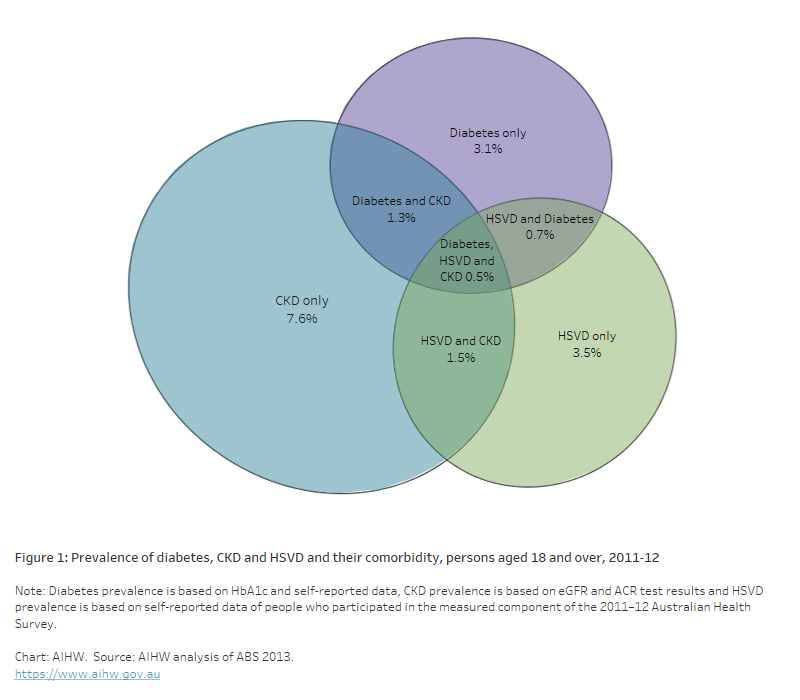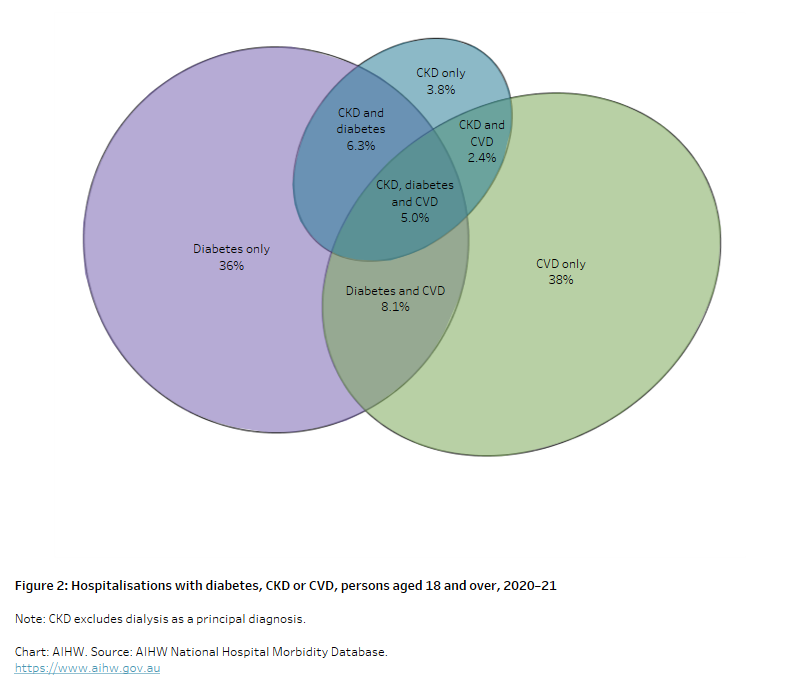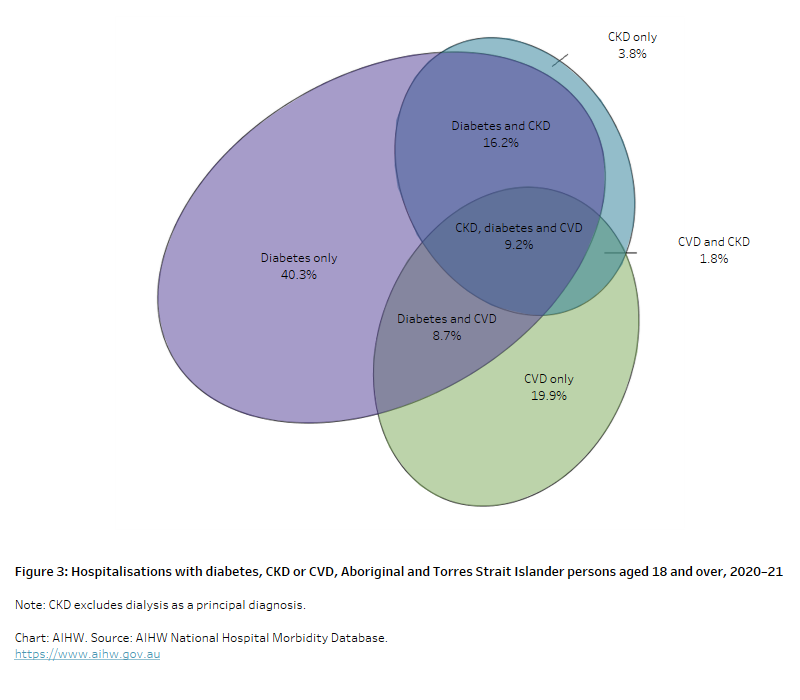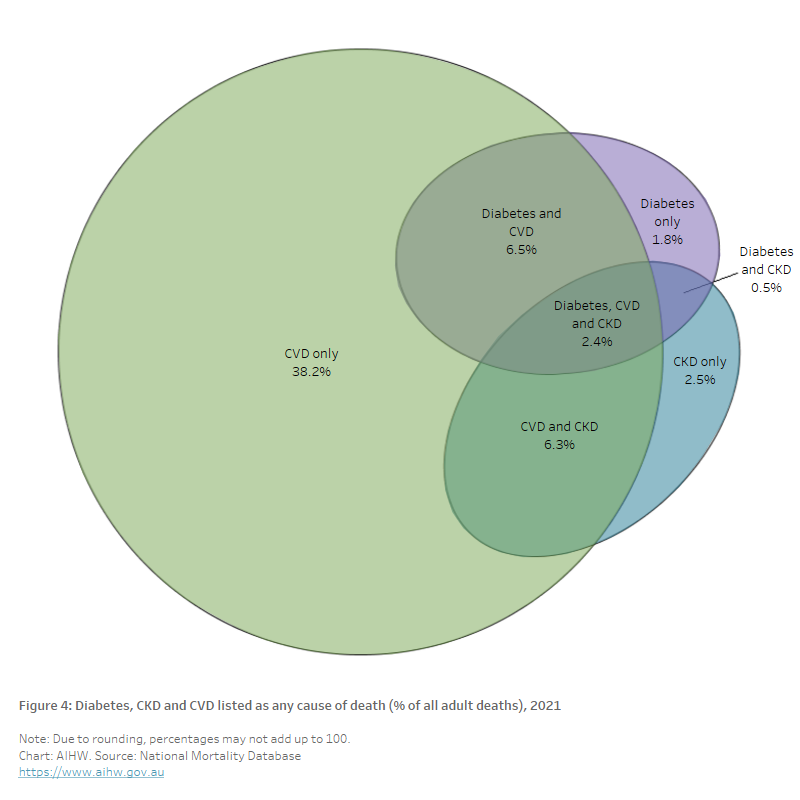Comorbidity of diabetes
Page highlights:
- In 2011–12, an estimated 2.8 million Australian adults (18%) were living with diabetes, chronic kidney disease and/or heart, stroke and vascular disease
Hospitalisations with chronic kidney disease, cardiovascular disease and diabetes
- Of the 1.2 million hospitalisations for diabetes in 2020–21, cardiovascular disease was the most common comorbidity (8.1%), with chronic kidney disease present in 6.3% of diabetes hospitalisations.
Deaths from chronic kidney disease, cardiovascular disease and diabetes
- 84% of diabetes deaths in 2021 also had chronic kidney disease and or cardiovascular disease recorded on the death certificate.
Diseases commonly associated with diabetes deaths
- Associated causes commonly listed where diabetes was the underlying cause of death in 2021 include coronary heart disease, kidney failure and hypertensive diseases.
What are multimorbidity and comorbidity?
1 in 5 (4.9 million) Australians were estimated to be living with multimorbidity in 2017–18 (ABS 2019). The terms multimorbidity and comorbidity are often used interchangeably within chronic condition and health-care reporting.
Comorbidity is defined as the occurrence of more than 1 condition or disorder concurrently. Possible combinations can consist of both physical conditions and/or mental disorders. Whereas multimorbidity is the presence of 2 or more chronic conditions in a person at the same time. These concepts are important for the way different parts of the health system view patients. The concept of comorbidity is useful for the secondary and tertiary-care settings, for example, an endocrinologist might treat a patient with type 2 diabetes as having comorbidity with other diseases. Multimorbidity is a more useful concept in the primary care setting where holistic care is provided that is not determined by the presence of any specific condition (Harrison et al. 2021).
The health effect of multimorbidity can be greater than the combined effect of individual conditions, leading to more severe illness, a poorer prognosis and premature death. People living with multimorbidity generally use more health services, including increased contact with primary healthcare services, with more complex hospitalisations and poorer outcomes than those living with a single condition.
How many people are living with diabetes, chronic kidney disease and heart, stroke and vascular disease?
Reliable estimates of the comorbidity of diabetes, chronic kidney disease (CKD) and heart, stroke and vascular disease (HSVD) in the Australian population can be derived from large-scale biomedical health surveys. The most recent of these was the National Health Measures Survey, the biomedical component of the 2011–12 Australian Health Survey (ABS 2013).
In 2011–12, an estimated 2.8 million Australian adults (18%) were living with diabetes, CKD and/or HSVD. Of these, 860,000 had diabetes, of which:
- 480,000 (3.1% of adults) had diabetes only.
- 201,000 (1.3% of adults) had diabetes and CKD.
- 103,000 (0.7% of adults) had diabetes and HSVD.
- 76,700 (0.5% of adults) had diabetes, CKD and HSVD (Figure 1).
Men were 2.3 times as likely as women to be living with all 3 conditions, after adjusting for age.
The prevalence of comorbidity of diabetes with CKD and/or HSVD increased with age, from 2.5% of adults aged 55–64 to 9.0% of adults aged 65 and over.
Figure 1: Prevalence of diabetes, CKD and HSVD, and their comorbidity, persons aged 18 and over, 2011–12
The Venn diagram shows the overlapping proportion of adults who had diabetes, chronic kidney disease or heart, stroke and vascular disease in 2011–12. Among adults with these conditions, an estimated 17% had diabetes only and 2.7% were living with all 3 conditions.

Hospitalisations with diabetes, chronic kidney disease and cardiovascular disease
Hospital comorbidity
Where a person has 2 or more of CKD, CVD or diabetes recorded in their episode of hospitalisation, this is referred to as comorbidity. Dialysis hospitalisations have been excluded because they are often performed as routine treatments on a same-day basis and have no other comorbid diagnoses recorded. Note also, the coding rule for diabetes – if present, diabetes is universally coded on a person’s hospital record. This is unlike CVD and CKD, which are coded only if they affected the care and treatment provided during the hospitalisation. This may under-report hospital comorbidity of these diseases.
In 2020–21, there were around 2.2 million hospitalisations in people aged 18 or over in which diabetes, CKD or CVD was present as the principal and/or an additional diagnosis. This equates to 23% of all non-dialysis hospitalisations for people 18 and older.
Of these, more than half (around 1.2 million) included a diabetes diagnosis, either alone (802,000 or 36%), or in combination with CVD and/or CKD (428,000 or 19%). The most common comorbidity including diabetes was CVD and diabetes (179,000 or 8.1%), with diabetes and CKD present in 139,000 hospitalisations (6.3%). There were a further 110,000 hospitalisations (5.0%) where all 3 conditions were present (Figure 2).
Figure 2: Hospitalisations with diabetes, CKD (excluding dialysis) or CVD, persons aged 18 and over, 2020–21
The Venn diagram shows the overlapping proportion of hospitalisations among adults in 2020–21 with diabetes, chronic kidney disease or cardiovascular disease as the principal and/or additional diagnosis. Among the hospitalisations for these conditions 36% were for diabetes only, and 5.0% of hospitalisations were for all 3 conditions.

Variation by age and sex
The rate of hospitalisations with comorbidity of CKD, CVD and/or diabetes increases with age.
In 2020–21, for example, people aged 45–64 were 7.0 times as likely to have a combination of diabetes and CVD recorded on their hospital record as people aged 18–44 (690 and 99 per 100,000 population, respectively). For those aged 65 and over, this difference increased to 30 times the rate of those aged 18–44 (3,000 and 99 per 100,000 population, respectively).
Men were more likely to be hospitalised with comorbidity than women. After adjusting for age, the rate of hospitalisation where all 3 conditions were recorded was 1.7 times as high for men as for women.
Hospital comorbidity in the Aboriginal and Torres Strait Islander population
In 2020–21, there were 96,600 non-dialysis hospitalisations of Indigenous people aged 18 and over where CKD, CVD or diabetes was present as a principal and/or additional diagnoses.
Of these hospitalisations, 34,800 (36%) recorded 2 or 3 of the conditions – 8,400 (8.7%) recorded diabetes and CVD together, 1,800 (1.8%) recorded CVD and CKD, 15,700 (16.2%) recorded CKD and diabetes, and 8,900 (9.2%) recorded all 3 conditions (Figure 3).
After adjusting for age differences in the populations, the rate of hospitalisation of Indigenous people recording all 3 conditions was 5.8 times as high as the rate of non-Indigenous people.
Figure 3: Hospitalisations with diabetes, CKD or CVD, Aboriginal and Torres Strait Islander persons aged 18 and over, 2020–21
The Venn diagram shows the overlapping proportion of hospitalisations among Indigenous adults in 2020–21 with diabetes, chronic kidney disease or cardiovascular disease as the principal and/or additional diagnosis. Among the hospitalisations for these conditions 40% were for diabetes only, and 9.2% of hospitalisations were for all 3 conditions.

Deaths from diabetes, chronic kidney disease and cardiovascular disease
Often, more than one disease or condition contributes to a death. Along with the underlying cause of death, a medical practitioner or coroner will also record associated causes on a death certificate. The most complete representation of cause of death will consider the contribution of both underlying and associated causes (Harding et al. 2014).
Whereas CVD is a common underlying cause of death, diabetes and CKD are more likely to be recorded as associated causes of death. Both diabetes and CKD are known to be under-reported in national mortality statistics and can be omitted from death certificates as contributory causes of death (McEwen et al. 2011; Sypek et al. 2018).
Association of diabetes, CKD and CVD
Of the 169,800 deaths registered among persons aged 18 and over in Australia in 2021, diabetes, CKD and CVD were listed as an underlying or associated cause in 99,100 deaths. In total, 58% of adult deaths had at least 1 of these 3 conditions recorded.
Diabetes was recorded as an underlying or associated cause in 19,300 deaths (11% of adult deaths) with 84% of these having CVD and/or CKD also recorded on the death certificate.
Of all deaths among adults in 2021:
- 26,800 (16%) had at least 2 of diabetes, CKD and diabetes recorded on the death certificate
- 3,100 (1.8%) had diabetes only recorded
- 11,100 (6.5%) had diabetes and CVD recorded
- 889 (0.5%) had diabetes and CKD recorded
- 4,200 (2.4%) had all 3 conditions recorded (Figure 4).
Figure 4: Diabetes, CKD and CVD listed as any cause of death (% of total adult deaths), 2021
The Venn diagram shows the proportion of deaths among adults in 2021 with diabetes, chronic kidney disease or cardiovascular disease as any cause of death. Among deaths from these conditions, diabetes was recorded as the only cause in 3.1% of deaths, and all 3 diseases were recorded as the underlying or associated cause in 4.2% of deaths.

Diseases commonly associated with diabetes deaths
Where diabetes was listed as the underlying cause of death in 2021, common associated causes of death include coronary heart disease (I20–I25), kidney failure (N17–N19) and hypertensive diseases (I10–I15) (Table 1).
| Associated cause of death | Per cent |
|---|---|
| Coronary heart disease (I20–I25) | 41.2 |
| Kidney failure (N17–N19) | 41.2 |
| Hypertensive disease (I10–I15) | 33.8 |
| Other ill-defined causes (R00–R94, R96–R99, I46.9, I95.9, I99, J96.0, J96.9, P28.5) | 29.8 |
| Heart failure and complications and ill-defined heart disease (I50–I51) | 21.4 |
| Dementia including Alzheimer's disease (F01, F03, G30) | 15.9 |
| Cerebrovascular disease (I60–I69) | 15.7 |
| Cardiac arrhythmias (I47–I49) | 12.9 |
| Diseases of arteries, arterioles and capillaries excl. atherosclerosis, aortic aneurysm and dissection (I72–I79) | 9.7 |
| Selected metabolic disorders excl. dehydration (E70–E89 excl. E86, E87) | 9.3 |
Source: National Mortality Database
Diabetes associated with other causes of death
The most common underlying cause of death where diabetes is listed as the associated cause in 2021 include coronary heart disease (I20–I25), dementia (F01, F03, G30), cerebrovascular disease (I60–I69) and chronic obstructive pulmonary disease (J40–J44) (Table 2).
| Underlying cause of death | Per cent |
|---|---|
| Coronary heart disease (I20–I25) | 19.2 |
| Dementia including Alzheimer's disease (F01, F03, G30) | 9.9 |
| Cerebrovascular disease (I60–I69) | 6.6 |
| Chronic obstructive pulmonary disease (COPD) (J40–J44) | 4.6 |
| Lung cancer (C33, C34) | 4.0 |
| Accidental falls (W00–W19) | 3.4 |
| Colorectal cancer (C18–C20, C26.0) | 2.5 |
| Pancreatic cancer (C25) | 2.3 |
| Hypertensive disease (I10–I15) | 2.1 |
| Prostate cancer (C61) | 2.0 |
Source: National Mortality Database
ABS (Australian Bureau of Statistics) (2013). Australian Health Survey, National Health Survey 2011–12, AIHW analysis of detailed microdata, accessed 19 May 2022.
ABS 2019. Microdata: National Health Survey, 2017–18, AIHW analysis of detailed microdata, accessed 4 March 2022.
Harding JL, Shaw JE, Peeters A, Guiver T, Davidson S and Magliano DJ (2014), 'Mortality trends among people with type 1 and type 2 diabetes in Australia: 1997–2010', Diabetes Care, 37(9): 2579–86, doi:10.2337/dc14-0096.
Harrison C, Fortin M, van den Akker M, Mair F, Calderon-Larranaga A, Boland F, Wallace E, Jani B, Smith S (2021), 'Comorbidity versus multimorbidity: Why it matters', Journal of Multimorbidity and Comorbidity, 11:1–3, doi:10.1177/2633556521993993.
McEwen L, Karter A, Curb J, Marrero D, Crosson J and Herman W (2011), 'Temporal trends in recording of diabetes on death certificates: results from Translating Research into Action for Diabetes (TRIAD)', Diabetes Care 34(7): 1529–33, doi:10.2337/dc10-2312.
Sypek MP, Dansie KB, Clayton P, Webster AC and Mcdonald S (2018), 'Comparison of cause of death between Australian and New Zealand Dialysis and Transplant Registry and the Australian National Death Index', Nephrology, 24(3): 322–9, doi:10.1111/nep.13250.


